Trees of the Adirondacks:
Eastern White Pine (Pinus strobus)

The Eastern White Pine (Pinus strobus) is a large conifer which flourishes throughout the Adirondack Mountains in upstate New York. It is the tallest of our native evergreens, often reaching 130 feet in height and four feet in diameter. This species is considered to be one of the most valuable trees in eastern North America. It is one of the signature trees of the Adirondacks.
Eastern White Pine is also referred to as the White Pine, Northern White Pine, Northern Pine, and Soft Pine. In Britain, this species is also called the Weymouth Pine – in honor of English explorer Captain George Weymouth, who took Eastern White Pine seeds to English from Maine in 1605. The Eastern White Pine is the state tree of both Maine (the Pine Tree State) and Michigan and the provincial tree of Ontario.
Identification of the Eastern White Pine
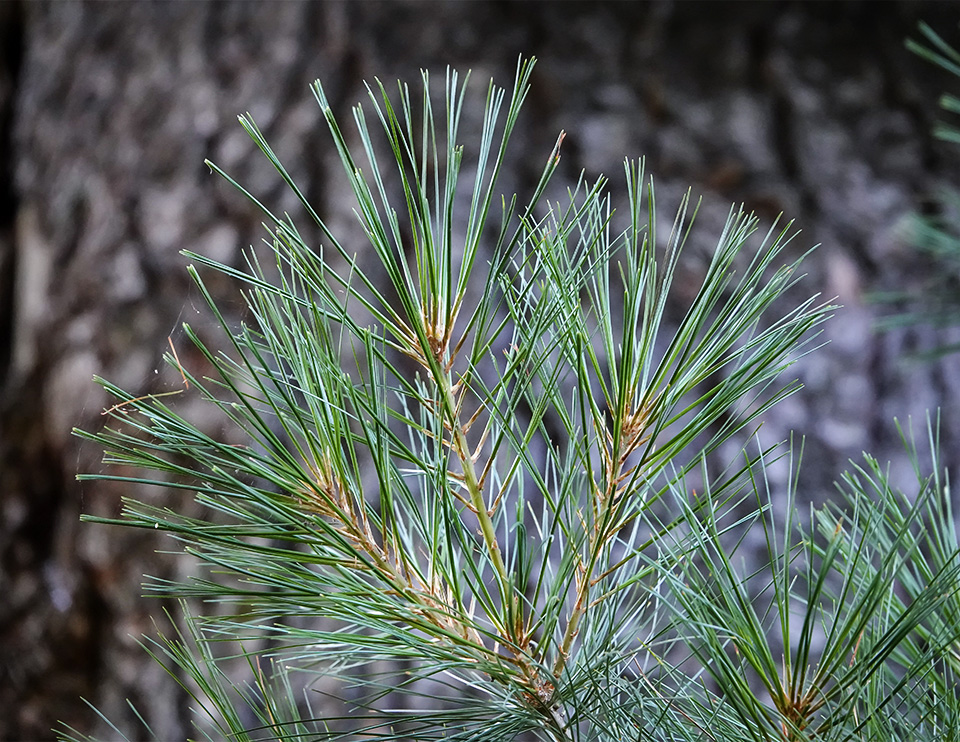
The Eastern White Pine is the largest eastern conifer, often growing up to 150 feet tall and up to 40 inches in diameter, depending on the soil. Michael Kudish lists a 275-year-old Eastern White Pine in Paul Smiths that was 49 inches in diameter.
The tallest tree on record in New York State is an Eastern White Pine. This tree, which can be seen in the Elders Grove (also known as the 1675 grove) in Easy Street (near Paul Smiths in Franklin County), is 160.4 feet tall, with a circumference of 13.1 feet and a diameter of 50.1 inches. This tree is one of about fifty Eastern White Pines, most of which are 330 plus years old. The fact that most of the trees are about the same age suggests that they probably germinated after a windstorm or some other disturbance.
The Eastern White Pine normally grows with a straight trunk and a crown of horizontal, parallel branches, with one row added a year, becoming broad and irregular as the tree ages. Because the tree grows higher than surrounding trees, it is subject to wind damage and the branches on the part of the tree that faces the winds often fall off.
This tree has clustered needles, growing five to a cluster. Each needle is three to five inches long, bluish green in color, and soft and flexible to the touch. The long, thin needles seem to whisper in the breeze.
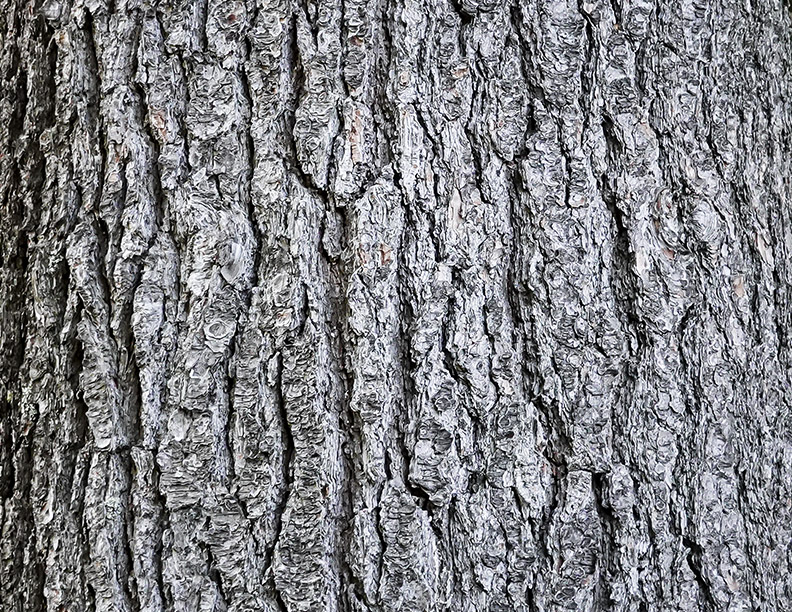
The bark of Eastern White Pine, like that of many trees, changes as the tree matures.
- When young, the bark is smooth and greenish gray in color.
- Mature Eastern White Pine trees develop bark with is grayish to reddish-brown, with layers of scales forming ridges that are broken into irregular blocks.
- As the tree ages further, the furrows in the bark deepen, and irregular, scaly blocks begin to curl outward on the top and bottom.
The cones are four to eight inches long and about one inch thick, with a pointed white tip. Cones are green when immature and turn yellow-green to light brown when ripe. Cones generally remain attached for one to several months after ripening in the fall of the second season.
Keys to identifying the Eastern White Pine and differentiating it from other maples include its needles, cones, and silhouette.
- Needle length and bundles provide a handy way to differentiate the Eastern White Pine from other pines that grow in the Adirondack region. The needles of both Red Pine and Eastern White Pine are about the same length, but Red Pine needles come in bundles of two, in contrast to the five-needle bundle of Eastern White Pine. Pitch Pine needles are about three inches long, and come in bundles of three. Jack Pine has short (1-2 inches), stout needles, organized in bundles of two. The non-native Scotch Pine has two- to -three-inch long needles, also organized in bundles of two.
- The long cones of Eastern White Pine contrast with the egg-shaped cones of Red Pine, Jack Pine, and Pitch Pine, as well as the ice-cream-coned shape of Jack Pine.
- Silhouette provides another clue. The Eastern White Pine has upswept branches; and, because it consistently outgrows its associates, its crown often emerges above the forest canopy. The Jack Pine is often small and spindly, with a narrow silhouette. The Red Pine typically has a dense, dome-like crown and often sheds its lower branches. Pitch Pine trees are irregularly limbed and branched, creating an unsymmetrical canopy.
Uses of the Eastern White Pine
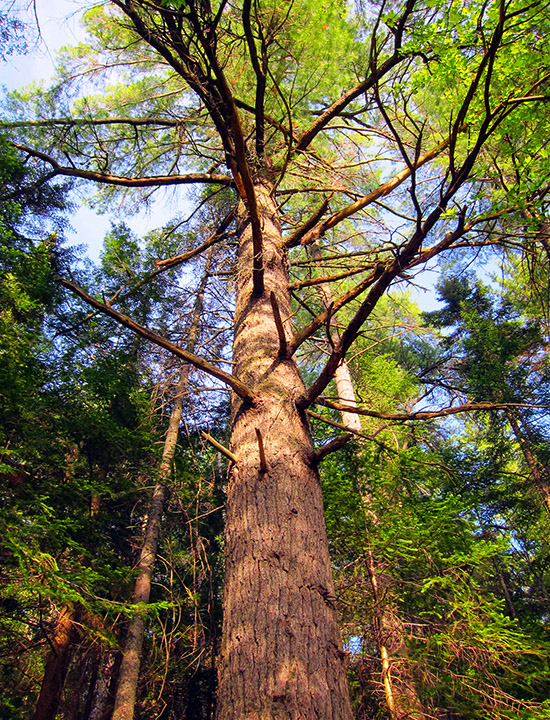
The Eastern White Pine is one of the most important timber trees in the Northeast. Its wood is light, durable, and easy to work; it stains and finished well. The wood is used for construction, millwork, trim, and pulpwood. It has also been used for doors, moldings, trim, and paneling. Eastern White Pine also provides good lumber for toys, boxes, cabinet work, and similar items.
In addition, the tree is used in Christmas tree plantations, as ornamental plants, and as a windbreak or screen. Pitch can be obtained from the resin and reportedly has been used for waterproofing canoes and as a wood preservative. In the colonial period, the long, straight trunks of the Eastern White Pine were used to make ship’s masts.
The plant has also edible uses, although it should be avoided by individuals suffering from asthma or bronchitis. The seed reportedly can be ingested raw or cooked, and is mainly used as a flavoring agent. The fresh needles can be brewed into tea which is rich in vitamins. Also, the inner bark is said to have been used as a thickener in soups, when dried and ground into a powder.
This plant reportedly was used as a medicine by several native North American Indian groups, primarily as an antiseptic. It was used extensively to treat skin complaints, wounds, burns, and boils. A poultice made from the pounded inner bark was said to be useful in the treatment of cuts, sores and wounds. The Algonquin reportedly used the wetted inner bark as a poultice on the chest in treating colds. The Delaware used an infusion of twigs for pulmonary diseases and kidney complaints.
Wildlife Value of the Eastern White Pine
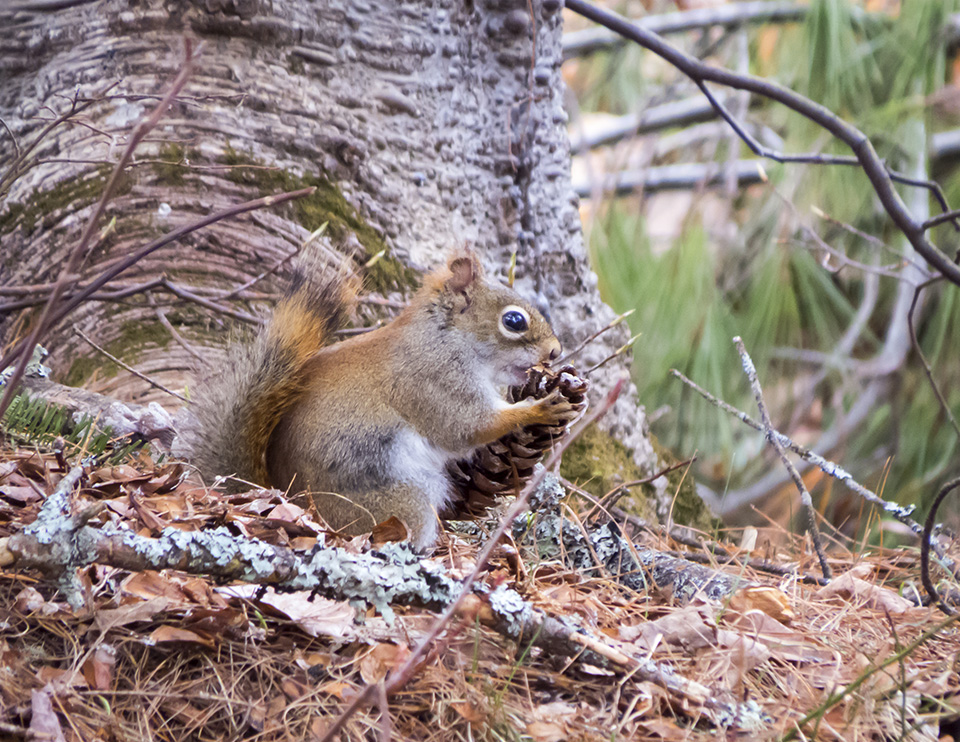
The Eastern White Pine ranks among the very top plants in terms of its importance to wildlife. The tree is is valuable for both food and cover for a wide variety of mammals and birds, and its bark, buds, foliage, and cones, are consumed by a number of insects.
Mammals that eat the seeds, bark, and foliage of Eastern White Pine include American Black Bears, American Beavers, Snowshoe Hares, North American Porcupines, Gray Squirrels, and Eastern Cottontails.
- White-footed Mice, Eastern Chipmunks, and Red Squirrels are the dominant mammal seed eaters. If you see large piles of stripped cones and cone scales at the base of a pine, it usually indicates a Red Squirrel midden, a term that refers to both the food cache and the debris that accumulates over months of stripping cones on a nearby log, branch, or stump.
- Snowshoe Hares feed on the twigs, buds, and bark during the winter. The Martin/Zim/Nelson study (1951) estimates that these foods comprises 25 to 50% of the Snowshoe Hare's diet in winter in northern New York.
- White-tailed Deer also consume Eastern White Pine, but only if little else is available. This species, like other pine species, is considered a starvation food in New York State.
Eastern White Pine is a common tree species in the breeding habitat of a wide variety of birds, including:
Species of songbirds that consume seeds of the Eastern White Pine include Yellow-bellied Sapsucker, Black-capped Chickadee, White-breasted Nuthatch, Pine Warbler, Pine Grosbeak, Red Crossbill, White-winged Crossbill, Evening Grosbeak, Red-breasted Nuthatch, and Pine Siskin.
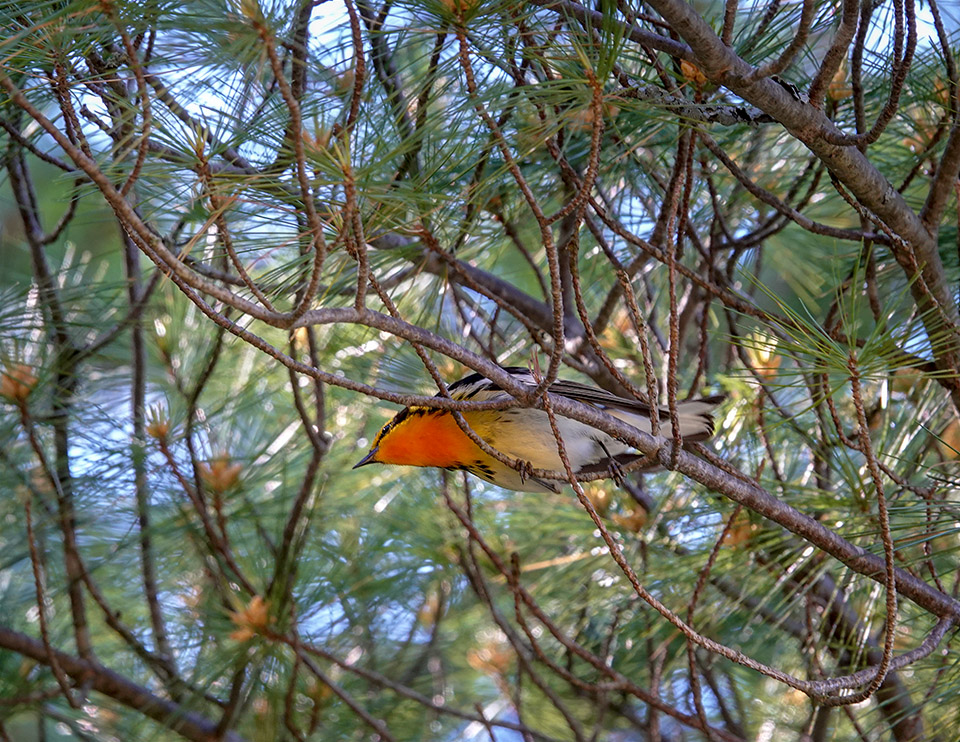
Eastern White Pines are used as nest sites by a number of birds, both year-round residents and summer migrants. Large pines are favored nesting sites for hawks and owls. Sharp-shinned Hawks and Cooper's Hawks usually place their nests on large branches next to the trunk. Broad-winged Hawks may build their nests in a crotch near the top of the tree. Great Horned Owls, Barred Owls, and Long-eared Owls reportedly adapt old hawk or crows nests for their own. Barred Owls often nest in trunk cavities and use the tree as a roost.
Eastern White Pines also provide nest sites for Boreal Chickadees, Orchard Orioles, Least Flycatchers, Blue Jays, Common Ravens, American Crows, and Common Grackles. Species which build nests on horizontal limbs or in branch foliage include Mourning Doves, Olive-sided Flycatchers, Magnolia Warblers, Yellow-rumped Warblers, Black-throated Green Warblers, Blackburnian Warblers, Bay-breasted Warblers, Pine Warblers, Evening Grosbeaks, Pine Grosbeaks, Purple Finches, and Pine Siskins. Pine needles are used as nest materials by several species of songbird, including Alder Flycatchers and Philadelphia Vireos.
Distribution of the Eastern White Pine
Eastern White Pine is found in northeastern United States and southern Canada. Its range includes southern Canada from Newfoundland, Anticosti Island, and Gaspé peninsula of Quebec; west to central and western Ontario and extreme southeastern Manitoba; south to southeastern Minnesota and northeastern Iowa; east to northern Illinois, Ohio, Pennsylvania, and New Jersey; and south mostly in the Appalachian Mountains to northern Georgia and northwestern South Carolina.
This species is present in every county in New York State, including all counties within the Adirondack Park Blue Line.
Habitat of the Eastern White Pine
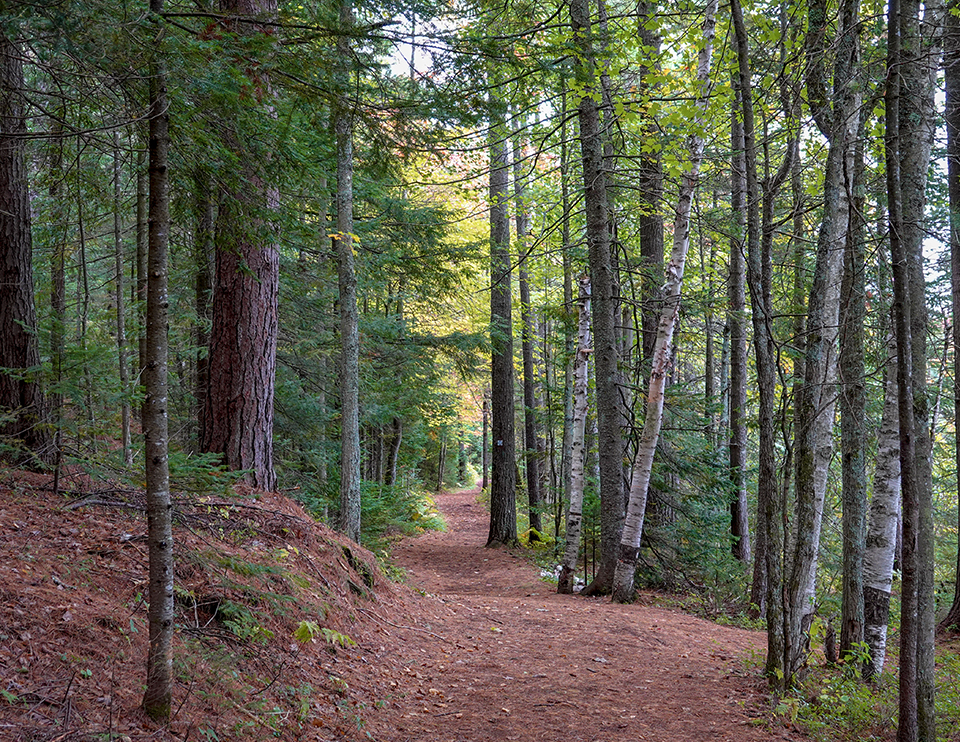
The Eastern White Pine is found in areas where the July temperature averages between 65 and 74 degrees. It can grow in a wide variety of soils, ranging from light, sandy soils to heavy, textured soils. The species is most frequently found on well-drained outwash soils, but is also present on well-trained tills. Eastern White Pine will also grow on imperfectly drained soils, but does poorly on the poorly drained sites. It is tolerant of drought, but cannot tolerate atmospheric pollution. The species is mid-tolerant to intolerant of shade; the tree must receive full sun at least for a good portion of the day.
Given these rather flexible requirements, Eastern White Pine flourishes in a wide variety of wet to dry habitats, including mixed wood forests, lowland conifer forests, and wetlands. It is frequently seen on the edges of lakes and ponds. Although it can be found in pure stands, this tree usually needs disturbances or openings to establish, and is therefore only a small component of the tree canopy in many forests.
Eastern White Pine is present in all successional stages. It is a pioneer species on old fields and other disturbed sites, reforesting abandoned fields, burned areas, and blowdowns. Eastern White Pines also become established after logging operations, particularly clearcuts. For instance, in the Forest Ecosystem Research and Demonstration Area (FERDA) plots, Eastern White Pine increased in abundance on four out of the five blocks a decade after logging. Eastern White Pine also functions as a long-lived successional species, and may be a component of climax forests throughout its range.
In the Adirondack Park, Eastern White Pine can be found in a wide variety of ecological communities:
- Acidic Talus Slope Woodland
- Appalachian Oak-Pine Forest
- Balsam Flats
- Black Spruce-Tamarack Bog
- Boreal Heath Barrens
- Calcareous Pavement Woodland
- Hemlock-Hardwood Swamp
- Hemlock-Northern Hardwood Forest
- Limestone Woodland
- Northern White Cedar Swamp
- Pine Plantation
- Pine-Northern Hardwood Forest
- Pitch Pine-Heath Barrens
- Pitch Pine-Oak-Heath Rocky Summit
- Red Pine Rocky Summit
- Rich Hemlock-Hardwood Peat Swamp
- Rocky Summit Grassland
- Sandstone Pavement Barrens
- Spruce Flats
- Spruce-Fir Swamp
- Spruce-Northern Hardwood Forest
- Successional Northern Hardwoods
Eastern White Pine is seen along most of the Adirondack trails covered here, particularly those which pass through Pine-Northern Hardwood Forests. This is a mixed wood forest that occurs on gravelly outwash plains, delta sands, eskers, and dry lake sands in the Adirondacks.
- In this ecological community, Eastern White Pine mingles with Red Pine, plus scattered specimens of Paper Birch, Yellow Birch, Red Maple, Balsam Fir, and Red Spruce.
- Characteristic shrubs include blueberries and Northern Wild Raisin.
- On the forest floor, look for wildflowers such as Clintonia, Bunchberry, Wintergreen, Canada Mayflower, Starflower, and Cow-wheat, as well as Eastern Bracken Fern.
- Mosses, such as Schreber's Big Red Stem Moss, and lichens may be common to abundant.
Adirondack Tree List
References
Michael Kudish. Adirondack Upland Flora: An Ecological Perspective (Saranac, New York: The Chauncy Press, 1992), pp. 40-42, 100, 248.
Michael Kudish. Paul Smiths Flora II: Additional Vascular Plants; Bryophytes (Mosses and Liverworts); Soils and Vegetation; Local Forest History (Paul Smith's College, 1981), pp. 123-125, 127, 133.
E. H. Ketchledge. Forests and Trees of the Adirondack High Peaks Region: A Hiker's Guide (Adirondack Mountain Club, 1996), pp. 50-54.
New York Flora Association. New York Flora Atlas. White Pine. Pinus strobus L. Retrieved 10 March 2017.
United States Department of Agriculture. The Plants Database. Eastern White Pine. Pinus strobus L. Retrieved 26 February 2017.
United States Department of Agriculture. NRCS National Plant Data Center & the Biota of North America Program. Plant Guide. Eastern White Pine. Pinus stobus L. Retrieved 26 February 2017.
United States Department of Agriculture. Forest Service. Silvics of North America. Eastern White Pine. Pinus strobus L. Retrieved 7 January 2015.
United States Department of Agriculture. Fire Effects Information System (FEIS). Species Reviews. Pinus strobus. Retrieved 10 March 2017.
Flora of North America. Pinus strobus Linnaeus. Retrieved 10 March 2017.
Northern Forest Atlas. Images. Pinus Strobus. White Pine. Retrieved 10 March 2017.
New England Wildflower Society. Go Botany. Eastern White Pine. Pinus strobus L. Retrieved 10 March 2017.
New York State. Department of Environmental Conservation. New York Natural Heritage Program. Ecological Communities of New York State. Second Edition (March 2014), pp. 71-72, 72, 75-76, 76, 95, 101-102, 102, 102-102, 103-104, 105-106, 107-108, 108-109, 110, 118, 121, 121-122,122, 122-123, 123, 125, 127. Retrieved 17 October 2015.
New York Natural Heritage Program. 2022. Online Conservation Guide for Acidic Talus Slope Woodland. Retrieved 29 March 2022.
New York Natural Heritage Program. 2022. Online Conservation Guide for Appalachian Oak-Pine Forest. Retrieved 29 March 2022.
New York Natural Heritage Program. 2022. Online Conservation Guide for Balsam Flats. Retrieved 29 March 2022.
New York Natural Heritage Program. 2022. Online Conservation Guide for Black Spruce-Tamarack Bog. Retrieved 29 March 2022.
New York Natural Heritage Program. 2022. Online Conservation Guide for Boreal Heath Barrens. Retrieved 29 March 2022.
New York Natural Heritage Program. 2022. Online Conservation Guide for Calcareous Pavement Woodland. Retrieved 29 March 2022.
New York Natural Heritage Program. 2022. Online Conservation Guide for Hemlock-Hardwood Swamp. Retrieved 29 March 2022.
New York Natural Heritage Program. 2022. Online Conservation Guide for Hemlock-Northern Hardwood Forest. Retrieved 29 March 2022.
New York Natural Heritage Program. 2022. Online Conservation Guide for Limestone Woodland. Retrieved 29 March 2022.
New York Natural Heritage Program. 2022. Online Conservation Guide for Northern White Cedar Swamp. Retrieved 29 March 2022.
New York Natural Heritage Program. 2022. Online Conservation Guide for Pine-Northern Hardwood Forest. Retrieved 29 March 2022.
New York Natural Heritage Program. 2022. Online Conservation Guide for Pitch Pine-Heath Barrens. Retrieved 29 March 2022.
New York Natural Heritage Program. 2022. Online Conservation Guide for Pitch Pine-Oak-Heath Rocky Summit. Retrieved 29 March 2022.
New York Natural Heritage Program. 2022. Online Conservation Guide for Red Pine Rocky Summit. Retrieved 29 March 2022.
New York Natural Heritage Program. 2022. Online Conservation Guide for Rich Hemlock-Hardwood Peat Swamp. Retrieved 29 March 2022.
New York Natural Heritage Program. 2022. Online Conservation Guide for Rocky Summit Grassland. Retrieved 29 March 2022.
New York Natural Heritage Program. 2022. Online Conservation Guide for Sandstone Pavement Barrens. Retrieved 29 March 2022.
New York Natural Heritage Program. 2022. Online Conservation Guide for Spruce Flats. Retrieved 29 March 2022.
New York Natural Heritage Program. 2022. Online Conservation Guide for Spruce-Fir Swamp. Retrieved 29 March 2022.
New York Natural Heritage Program. 2022. Online Conservation Guide for Spruce-Northern Hardwood Forest. Retrieved 29 March 2022.
Lady Bird Johnson Wildflower Center. Pinus strobus L. Retrieved 11 March 2017.
Online Encyclopedia of Life. Pinus strobus. Eastern White Pine. Retrieved 11 March 2017.
New York State Department of Environmental Conservation. Winter Deer Foods. Retrieved 11 March 2017.
Flora of Wisconsin. Pinus strobus L. Retrieved 11 March 2017.
William K. Chapman and Alan E. Bessette. Trees and Shrubs of the Adirondacks: A Field Guide (North Country Books, 1990), p. 19, Plate 2.
Stan Tekiela. Trees of New York: Field Guide (Adventure Publications, Inc., 2006), pp. 28-29.
Michael Wojtech. Bark: A Field Guide to Trees of the Northeast (University Press of New England, 2011), pp. 200-203.
Gil Nelson, Christopher J. Earle, and Richard Spellenberg. Trees of Eastern North America (Princeton : Princeton University Press), pp. 62-75.
Mark J. Twery, at al. Changes in Abundance of Vascular Plants under Varying Silvicultural Systems at the Forest Ecosystem Research and Demonstration Area, Paul Smiths, New York. USDA Forest Service. Research Note NRS-169. Retrieved 22 January 2017, p. 6.
Alexander C. Martin, Herbert S. Zim, and Arnold L. Nelson. American Wildlife & Plants. A Guide to Wildlife Food Habits (Dover Publications, 1951), pp. 231-232, 237-239, 261-262, 287-289. Retrieved 12 February 2019.
John Eastman. The Book of Forest and Thicket: Trees, Shrubs, and Wildflowers of Eastern North America (Stackpole Books, 1992), pp. 151-157.
Tom Kalinowski, "Natural History: The Ecology of Adirondack Fires," Adirondack Almanack, 26 March 2012. Retrieved 17 February 2017.
Plants for a Future. Pinus Strobus L. Retrieved 11 March 2017.
Steven Foster and James A. Duke. Medicinal Plants and Herbs of Eastern and Central North America (Houghton Mifflin Harcourt, 2014), pp. 341-342.
Bradford Angier. Field Guide to Edible Wild Plants. Revised and Updated. (Stackpole Books, 2008), pp. 168-169.
Lee Allen Peterson. A Field Guide to Edible Wild Plants. Eastern and Central North America (Houghton Mifflin Company, 1977), pp. 168-169.
University of Michigan. Native American Ethnobotany. A Database of Foods, Drugs, Dyes and Fibers of Native American Peoples, Derived from Plants. Eastern White Pine. Pinus strobus L. Retrieved 11 March 2017.
The Cornell Lab of Ornithology. Birds of North America. Golden-crowned Kinglet, Hairy Woodpecker, Northern Saw-whet Owl, Northern Parula, Eastern Whip-poor-will, Magnolia Warbler, Chipping Sparrow, Pine Warbler, Yellow-bellied Flycatcher, Canada Warbler, Mourning Warbler, Blackburnian Warbler, Barred Owl, Turkey Vulture, Gray Jay, Boreal Chickadee, Orchard Oriole, Cooper's Hawk, Broad-winged Hawk, Least Flycatcher, Alder Flycatcher, Philadelphia Vireo, Red Crossbill, White-winged Crossbill. Subscription web site. Retrieved 8 March 2017.
George A. Petrides. A Field Guide to Eastern Trees (Boston: Houghton Mifflin Company, 1998), pp. 34, 35, 159.
John Kricher. A Field Guide to Eastern Forests. North America (Boston: Houghton Mifflin, 1998), pp. 62-67, 122.
Mary Thill, "New York's Tallest Tree," Adirondack Life. Retrieved 11 March 2017.
